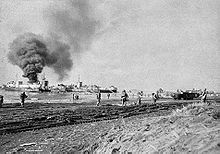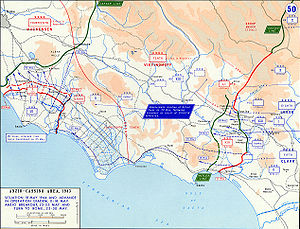Operation Shingle
| date | January 22 to May 25, 1944 |
|---|---|
| place | Anzio ( Italy ) |
| output | Allied victory after German withdrawal |
| Parties to the conflict | |
|---|---|
| Commander | |
|
|
|
| Troop strength | |
| 22 Jan 1944: 36,000 soldiers and 2,300 vehicles End of May: 150,000 soldiers |
22 Jan 1944: 20,000 soldiers End of May: 135,000 soldiers |
| losses | |
|
May 22 approx .: 29,200 casualties (7,000 dead, 18,000 wounded, 6,800 missing) |
May 22 approx .: 27,500 casualties (5,500 dead, 17,500 wounded, 4,500 missing) |
1940–1945: Air raids on Italy
1940: Attack on Taranto
1943: Operation Husky - Invasion of Italy ( Baytown , Avalanche , Slapstick ) - Armistice of Cassibile - Fall of the Axis
1944: Battle of Monte Cassino - Operation Shingle - Position of Goth
1945: Spring Offensive
Battle of Anzio ( shingle the English word for roof shingle , shingle beach the name for a made up of flat stones beach form) was one of the 22 January 1944 Allied performed page amphibious landing operation on the Italian theater of war around Anzio and Nettuno on the Tyrrhenian Sea in central Italy. It took place at the beginning of the Battle of Monte Cassino . The US VI Corps under Major General John P. Lucas was mainly involved in the operation. The aim of the Allies was to bypass the German main line of defense in central Italy ( Gustav Line ) in order to accelerate the advance on Rome . The operation and its ensuing skirmishes are also known as the Battle of Anzio .
prehistory
After units of the 5th US Army and the British 8th Army landed near Salerno and southern Italy as part of the Allied invasion of Italy in September 1943 , the Allied advance stopped at the German Gustav Line at the end of 1943 - about 100 kilometers south of the psychologically important goal Rome. The Allied commanders then began planning to break the deadlock of the front line with an amphibious landing operation behind the front near Rome.
One of the biggest problems in attack planning was the availability of landing craft , as these should be available for other operations, such as the later Normandy landings . Originally there were only so many LSTs (Landing Ship, Tank) available that only one division could have been deployed at a time. At the end of December 1943, the Allied commanders in Tunis decided to provide enough dropships for two divisions.
planning
The coastal plain 40 kilometers south of Rome at the northern end of the Pontine plain near Latina (former name: Littoria ) was selected as the landing area . At its center were the coastal towns of Anzio and Nettuno . The landings on the cut-off date of the operation were to be carried out by the 1st British and 3rd US Infantry Divisions, with the support of tank and paratrooper units, as well as ranger and commando units . After the successful landing, the landing convoy should return to Naples and transport two more divisions to the landing zone. The allied units were the VI. US Corps under the command of John P. Lucas. The Allies reckoned with five or six German divisions, some of them reduced in strength, in the target area, which could arrive over several days. The landing should be prepared by attacks on airfields of the air force and supply lines and tactical air support and fighter protection would be available for the duration of the operation.
The defensive positions of the Gustav Line in the hilly area of southern Lazio between the Abruzzo and the Mediterranean coast were to be put under pressure several days before the landing by attacks by the 5th US Army under General Mark W. Clark in order to defend the German 10th Army to bind there and to cause the Commander-in-Chief South, Field Marshal Kesselring , to withdraw troops from the area of Rome to the front. The Allied plan then provided that if German units withdrew from the Gustav Line to fight the landing forces, the line should be attacked and broken. Otherwise, the troops that landed at Anzio should advance through the Alban Hills on Rome and threaten the German units on the Gustav Line with being cut off. If, on the other hand, the Germans had been able to muster enough units to defend Rome and the line, Operation Shingle would at least have ensured that German troops would have been tied up in central Italy and thus would not have been able to take part in the fighting on other fronts.
The plan was approved on January 12th and the landing day was set on January 22nd. Major General Lucas seemed to have little confidence in the plan and its superiors. He drew parallels to the Allied Forces' ultimately failed Gallipoli company in World War I (1915/16). Like Shingle, it went back to Winston Churchill . Notes on this can be found in Lucas' diary.
The landing operation
The landing was preceded by attacks by the 5th US Army on the Gustav Line from January 16 (see Battle of Monte Cassino ). These prompted General Heinrich von Vietinghoff to request support from Kesselring. Thereupon the 29th and 90th Panzer Grenadier Divisions were withdrawn from Rome and assigned to the defensive line.
In the morning hours of January 22, 1944, British and US troops landed near Anzio and Nettuno with the help of nine transport ships and 226 landing craft. A total of 36,000 soldiers and 3,200 vehicles were sold. There was little resistance from the Germans. The Allies had 13 casualties and 97 more soldiers were wounded. Almost 200 German soldiers were taken prisoners of war.
The British 1st Infantry Division advanced three kilometers inland, the 3rd US Infantry Division about five kilometers. Nettuno and the port of Anzio could be conquered.
Although the German resistance in the area was low, Lucas did not take the opportunity to make a quick advance towards Rome, but instead remained defensive, using people and materials to build the American bridgehead. Churchill was extremely angry with this approach, as Lucas hardly threatened the German defenders. He was replaced on February 23, 1944 by Lucian K. Truscott .
Countermeasures by the Germans
Field Marshal Kesselring was informed of the Allied landings on January 22nd at 3 a.m. and at around 5 a.m. ordered the 4th Parachute Division and parts of Parachute-Panzer Division 1 Hermann Göring to defend the roads from Anzio to the Alban Mountains .
On January 25, the German 14th Army under Colonel General von Mackensen took over the defense of the Anzio / Nettuno section. At the end of the month, additional units from Italy and one division each from the Balkans and one from France were incorporated into his army. On February 14th, the German LXXVI. Panzer Corps under General der Panzertruppe Herr carried out a large-scale attack on the bridgehead, which, however, was unsuccessful due to the Allied superiority in air and water. However, due to a further advance on February 17, the Americans got so much distressed that the Allied commanders considered abandoning the section. However, this attack, as well as another one that took place at the end of February, was successfully repelled.
Ship losses
During the landing and in the weeks after, German bombers from Kampfgeschwader 40 and Kampfgeschwader 100 attempted to attack the sea units with remote-controlled bombs of the type FX 1400 and Hs 293 .
Were sunk by air raids
- on January 23, 1944 the destroyer HMS Janus
- on January 24, 1944 the hospital ship St. David with 2702 GRT
- on January 29, 1944 the cruiser HMS Spartan and the transporter Samuel Huntington (7181 GRT)
- on February 16, 1944 the Elihu Yale transporter (7176 GRT).
In order to protect the landing fleet and the supply ships from the German air raids, three Allied destroyers ( USS Plunkett , USS Frederick C. Davis and USS Herbert C. Jones ) were used, which began by disrupting the remote control signals of the remote-controlled German glide bombs. However, these measures were not entirely successful. So the destroyer working with interfering signals became Herbert. C. Jones damaged on February 15, 1944 by an attack with a Henschel Hs 293 glide bomb and the destroyer HMS Inglefield - not equipped with a jammer - sunk on February 25, 1944 also by the use of Henschel Hs 293.
The German submarine U 410 sank the Liberty ship Fort St. Nicolas (7154 GRT) on February 15, 1944 and the cruiser HMS Penelope on February 18 . U 952 sank the William B. Woods , a Liberty ship with 7,176 GRT on March 10, 1944 .
End of the operation
The battle for Monte Cassino did not lead to a decisive breakthrough through the German positions until May 1944 ( Operation Diadem ). Thereafter, the forces of the Anzio bridgehead were reinforced to prepare the attack on the approaches to Rome. On May 25, the II. US Corps, coming from the east, established the connection with the VI. Corps. After that, the VI. Corps launched its attacks west of the Alban Hills. On the night of June 2 to 3, the German units still in the Caesar line before Rome withdrew north of the city. On June 4, the 1st US Armored Division and the 36th US Infantry Division marched into Rome.
The further advance of the Allied armies only came to a halt in July 1944 at the Arno Line or Gotenstellung .
Military cemetery and memorial
There is an American military cemetery and a memorial near Nettuno (English: Sicily – Rome American Cemetery and Memorial ; Italian: Cimitero americano di Nettuno ).
A German military cemetery ( Cimitero militare germanico di Pomezia ) is located 2 km south of Pomezia on the SR 148 Via Pontina .
Web links
- Anzio Beachhead (22 January-25 May 1944) - American Forces in Action Series
- The Second World War in Color (7:05 min)
Individual evidence
- ↑ d'Este, Carlo (1991). Fatal Decision: Anzio and the Battle for Rome. New York: Harper. ISBN 0-06-015890-5 .
- ↑ a b Lamson, Maj. Roy, Jr. and Conn, Dr. Stetson (1948). Anzio Beachhead (22 January-25 May 1944) , CMH Online bookshelves: American Forces in Action Series. US Army Center of Military History. Washington CMH Pub 100-10. P. 116
- ^ Sicily - Rome American Cemetery and Memorial , website of the American Battle Monuments Commission .



